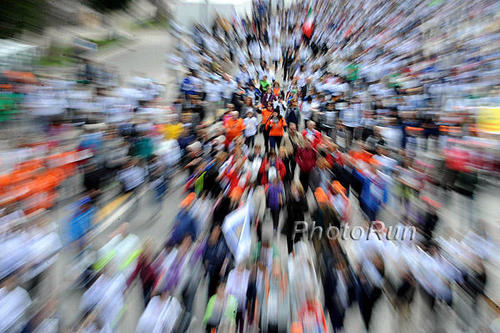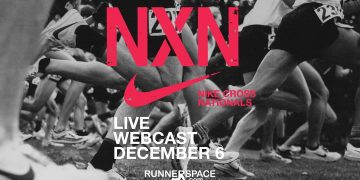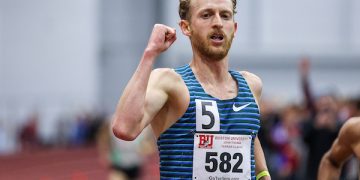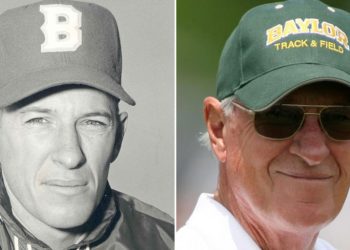 Crowd photo, from PhotoRun.net
Crowd photo, from PhotoRun.net
Jeff Benjamin did the review below on the new film, ‘Free to Run.’ Jeff will be providing some columns from Rio on his experience as a track fan.
“Free to Run” Film Review by Jeff Benjamin
To take on the rise of the “Running Boom” not only from an American but worldwide perspective is no easy chore. But in this new documentary film, “Free to Run”, director Pierre Morath attempts to show how the 1960’s fringe, cult- like sport of distance running evolved into the huge sport of the masses, using key events and people, but also bringing along a strong supporting cast as well. Yet while the movie does a good job delving into the almost 50 year growth of the “Boom”, it’s topics and chapters do jump around and attempt to smoothly intersperse throughout the entirety of the film. Frank Shorter and Roger Robinson seem to flow in and out of all of the chapters in the film. This writer has decided instead to take those key moments and write about them separately.
#1 – The NYC connection–With appearances by stalwarts George Hirsch, Norb Sander, Gary Muhrcke, Nina Kuscik and Peter Roth among others, Morath attempts to show the NYC influence of the late 1960’s into the 1970’s running scene, culminating with the appearance of Fred Lebow, presenting his life and the rise of both the New York Road Runners Club and the NY Marathon. The 1976 NY Marathon, which was the first conducted throughout the 5 boroughs, focused on Shorter and Bill Rodgers and the impact of their appearance in the race. While this ground has been tread upon before, (notably in the Lebow documentary, “Run for Your Life”), it was quite refreshing to see other key players from the era, notably Gloria Averbuch. The director also portrays the controversial topic of the under the table money payments at the time conducted by Lebow, thereby leading to battles with national and international federations, a theme presented by Morath throughout the film.
#2- The rise of women–Correctly portraying the chauvinism towards women distance running (masterfully showing the 1928 Women’s Olympic 800 and having Robinson discuss the event and it’s aftermath) Morath quite correctly uses as his focal point Kathrine Switzer, along with a bit of Nina Kuscik and Roberta Gibb, and uses the Boston Marathon as the genesis point of this movement. For this writer, it seemed that Morath did his homework, especially in finding rare film footage of Race Director Jock Semple trying to physically remove Switzer off the course in the 1967 race. This chapter then moves on to the rise of women runners, along with their fights with the federations, which culminates in the Avon race series and the 1984 Women’ Olympic Marathon, both showing the triumph of Joan Benoit and the struggling finish Gabriel Andersen-Schiess which, to Switzer’s surprise, turned out to be an inspirational moment as well.
#3 — The Swiss Connection–while this writer was familiar with the Swiss magazine Spiridon, founder Noel Tamini’s background and influence was not known. Morath gives great justice to Tamini and his crew, as the running scene was almost developing in a way parallel to the events taking place in the U.S. Tamini had his conflicts with the national federation as well, perhaps in a more confrontational setting. He even brought Switzer in for a race in his fight for not only women, but all runners as well.
#4 –Pre–In ground already broken by past films (notably “Fire on the Track) Morath shows the rise of Steve Prefontaine, his open fights with the AAU over athletes’ rights and compensation, as well as the development of Nike. All the usual suspects–Mac Wilkins, Pat Tyson, Tom Jordan, Jeff Johnson and Kenny Moore — all get their chance to once again emphasize the impact of Pre and Nike on the running scene. There are also appearances by Joe Henderson and John Henderson (not related!) who discuss the rise of money in road racing and track and field, which was exacerbated after Pre’s tragic death in 1975.
#5- The rise of the Big City Marathon–This, I believe, is Morath’s best part, in that while written about previously (Notably in Cameron Stracher’s book “Kings of the Road”) , the film shows that the 1990-Present impact of the Big City Marathon and the changing dynamic of runners and joggers have sent the Sport in a direction in which none of the pioneers ever believed it could go. “What happened to my Sport?”, asks Gary Muhrcke incredulously. With the rise of the business/corporate angle, Morath correctly states that it was the end of an era. The only question was that with the mass participations and the commercialization, could it still be a positive experience despite the lamenting of the “Old Guard”? “After all,” said Sander. “What could we do?”
Echoed Robinson, “there is a darker side to what we’ve achieved”.
It was at this point that Morath waded through the 2012 Hurricane Sandy disaster and tragic aftermath along with the controversial and loud backlashed-filled reaction toward the NYRR, CEO Mary Wittenberg and NYC Mayor Bloomberg, who vainly tried to keep the Marathon from being cancelled. Morath showed that this topic was truly one-sided, in that it seemed the Sport had taken a well-deserved hit from the mainstream public. To his credit, Hirsch admitted that, “in hindsight we were wrong.” Morath also showed the backlash in Central Park as runners on the cancelled Marathon day participated in a “Run Anyway Marathon” in Central Park, which was much-derided by the Public.
It seems that, while the film does move in and out of the various events sometimes inconsistently, Morath, along with his subjects, all seem to emphasize the same feeling–that running is a truly helpful and holistic positive for people. As the now octogenarian Tamini expresses,
“Nothing can replace the feeling!”
Perhaps Morath’s greatest contribution is putting together this film as a primer for the new generation. When someone discovers the joy of running, they may want to spread the word and advocate its benefits to the masses. With “Free to Run”, those people now have in their possession the path run before by others, and, for better or for worse, , the “lay of the land” today.
Author
-

Jeff Benjamin has written for 30 years for American Track and Field along with RunBlogRun. The Former President of the Staten Island AC & Chair of the Staten Island Running Association was the 5th man scorer for his Susan Wagner High School NYC XC City Championship team. Also a member of the College of Staten Island Sports Hall of Fame for XC, Jeff currently serves as the LDR Chairman for USATF NY. A passionate (or fanatical) follower of the Sport, some of Jeff's subjects have included Sebastian Coe, Emma Coburn, Eamonn Coghlan, Matt Centrowitz, Jim Spivey, Galen Rupp, Joe Newton, Tom Fleming, Ajee’ Wilson, Bill Rodgers, Allan Webb, Abel Kiviat, Jordan Hassay, Marty Liquori, Caster Semenya, Rod Dixon, Carl Lewis and Jim Ryun as well as Book Reviews and articles covering meets and races in the Northeast U.S.
View all posts





















